-
Posts
2,284 -
Joined
-
Last visited
-
Days Won
6
Content Type
Profiles
Forums
Blogs
Gallery
Events
Store
Posts posted by PKeating
-
-
Interesting to hear of the KM version in the group offered by Huss. It is entirely logical that the KM would have had their own version but given the paucity, for instance, of photos of KM sailors serving in North Africa wearing the KM "Afrika" service cuff title, sailors do not seem to have worn cuff titles much at all. In fact, I cannot even recall any photos showing sailors with campaign bands like "Kreta" and "Afrika". Not that I have studied the KM in any great detail but this thread has prompted some thoughts thereon.
Not KM, I know, but it's a wonderful shot from the viewpoint of anyone interested in KB. This shows some KB of the Fallschirm-Propaganda-Kompanie being interviewed just after receiving their jump badge documents. The paratrooper on the left wears the Luftwaffe other ranks pattern "Kriegsberichter der Luftwaffe" cuff title, as does the Junior NCO interviewing the leutnant with the early side-lacing jumpboots. The officer pattern KBdLW cuff title can be seen on the tunic of the officer on the right and the leutnant wears one on his fliegerbluse in other photos from the same series.
Kriegsmarine KB cuff titles would presumably have followed LW practice, with plain embroidered types for other ranks and wire embroidered, bordered types for officers. One thing I have not seem, however, is an NCO's pattern KBdLW cuff title with cotton or rayon "Russia braid" borders, as per, for instance, Fallschirmj?ger-Rgt and squadron cuff titles. The NCO with the microphone wears an unbordered type.
PK
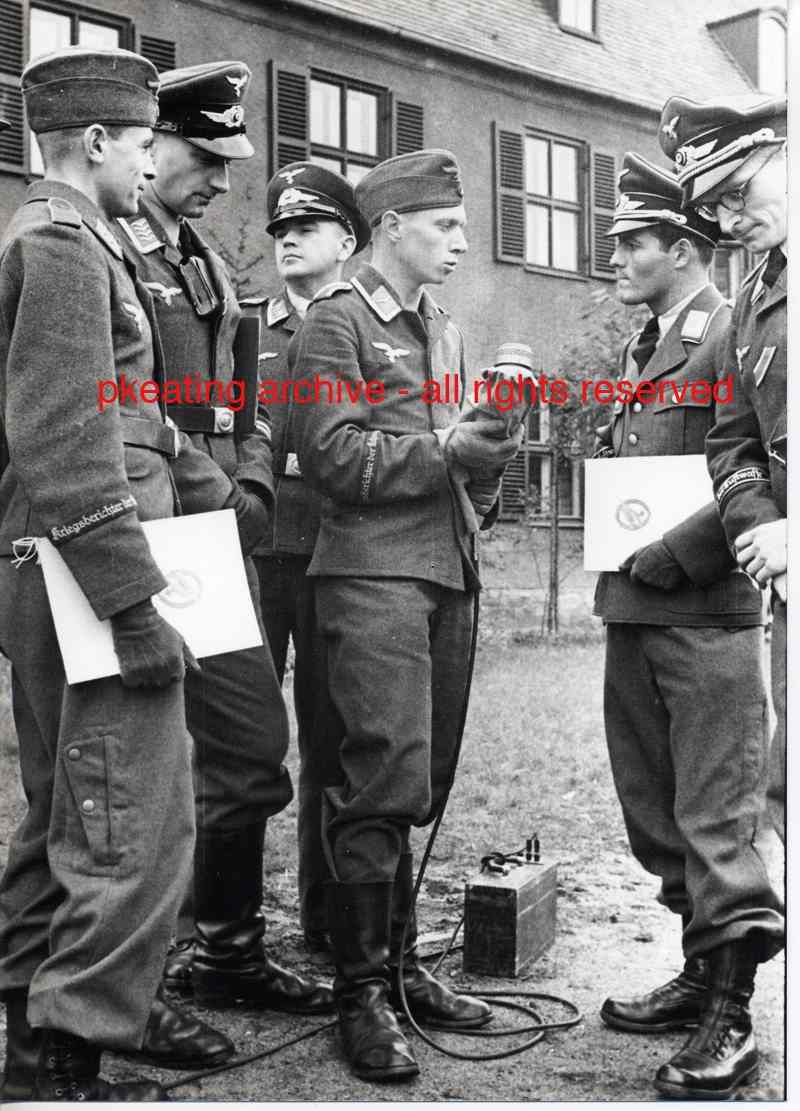
 0
0 -
Wehrmacht war reporters wore cuff titles with the legend "Kriegsberichter" and, in the case of the Waffen-SS, "SS-Kriegsberichter" and "Kurt Eggers". These cuff titles conformed to branch-of-service dress regulations. The Heer "Kriegsberichter" cuff title is extremely rare and not often seen in photographs. One sees the Waffen-SS and Luftwaffe type more frequently. I am not even convinced that the Kriegsmarine had such a cuff title; I have seen KM KB cuff titles that were clearly postwar fabrications but have never seen one I felt was wartime and nor do I recall ever seeing one worn in a wartime photograph. The chap to ask, I think, would be a KM student and collectorw like Gordon Williamson. Otherwise, propaganda-kompanie war reporters simply wore normal uniforms.
PK
0 -
Aha! In my opinion, this riband feels "old" and "period". Very interesting information, Rick. Thank you. The riband came with an early Souval fake Knight's Cross. As Souval is a Viennese firm, it would seem logical that this was indeed intended for old-style medal bars worn by Austrians and Hungarians harkening back to Hapsburg times.
PK
0 -
Having also seen Fran?ois' collection on a couple of occasions, I concur with Gordon. There is nothing wrong with any of the items shown here. Fran?ois is not only very knowledgeable but also very cautious and discerning when adding to his collection. He is one of the few serious collectors in his field in France and anyone thinking of buying anything from Fran?ois Saez should have no cause for concern of any kind.
PK
0 -
Dave,
Awards for mercenaries is an interesting topic. A good friend of my family was decorated by the short-lived Katangese government for his leadership of a mercenary unit in that part of the Congo in 1961. Mind you, he was fighting for the government in question. Had he been fighting for the Belgians, suppressing the natives, it would not have been quite the same thing.
I did not describe "mercenaries" as a euphemism. I said that "civilian defence contractors" was a euphemism for "mercenaries". Conversely, you are too smart not to understand that I am not talking about cooks, drivers, ditchdiggers and sundry gofers. The term "private security contractors" is even more "sinister" in this respect. Irregular soldiers, corporate paramilitaries, call them what you will, are estimated to outnumber regular or legitimate soldiers by almost four to one in Iraq. These men are, for the most part, clearly in it for the money. Many are Americans but many are from Britain and other countries.
mer?ce?naryPronunciation: 'm&r-s&-"ner-E, -ne-rE
Function: noun
Inflected Form(s): plural -nar?ies
Etymology: Middle English, from Latin mercenarius, irregular from merced-, merces wages -- more at MERCY
: one that serves merely for wages; especially : a soldier hired into foreign service
I think the term "mercenaries" is a fair way of describing the corporate private military units controlled by firms like KBR and Blackwater and I think that it is reasonable to mention this in a discussion about eligibility for the Defence Medal of Freedom, especially as civilian defence contractors do seem to be eligible for it. If any of these gunmen receive one, it will represent a sea change in official Western attitudes to mercenary forces, although our rulers are, of course, somewhat hypocritical when it comes to mercenaries. London, for instance, was quite content to see parts of Sierra Leone cleaned up by a mercenary force run by ex-British Army officers with close ties to Whitehall but threw a diplomat to the lions for assisting the mercenaries on the ground. Federal awards for KBR and Blackwater mercenaries would also be a public finger-flipping exercise with regard to the UN resolution I quoted. Current White House contempt for the UN as an organisation is hardly a secret but one must nevertheless maintain a fa?ade of decorum in such matters!

However, I'm not going to be drawn into a ideological debate with you about the function of hired gunmen in Iraq, Dave. In any case, such a discussion would be futile because I am not actually against the presence of these gunmen in Iraq. I wouldn't mind seeing them patrolling European cities too and hosing down some of our jihadis and their little helpers. My point was purely that rendering them eligible for state awards might prove a tough sell for the administration's spinmeisters once what is left of your investigative press got their teeth into it. That's all. No need to be so sensitive! It falls well within scope of a discussion about civilian awards for merit and valour.
Of course, it all depends up the definition of "mercenary". Foreign volunteers serving in the French Foreign Legion, for instance, could be described thus. So could Nepalese volunteers in the Gurkha units of the British Army. Going back a little further - and I expect Ed might have something to say - one could at a push describe the soldiers employed by the Honourable East India Company in early colonial days in India as mercenaries. This raises a question over the actual status of the Indian Army of the Raj era. Sure, this is off-topic in this particular section but it is surely alright to mention such subjects in passing as part of a global discussion about official awards for unoffical soldiers, isn't it?
Were we sitting in a pub talking about this, we wouldn't have someone saying "off topic" every time the conversation dipped and dived into other matters as participants added to the richness of its tapestry work, would we? Bringing it back to the United States, I see a clear parallel between, say, Halliburton in Iraq and the r?le of The Ohio Company in what Sir Winston Churchill - half-American himself - described as "the first First World War" in the 1750s, with Dick Cheney in the part of Robert Dinwiddie. They didn't have medals for valour as such back then but George Washington would have qualified for one as a result of his artifical elevation to hero status after the debacle of Fort Necessity. He might have been decorated a second time after the Battle of the Wilderness too. Mind you, as a mere civilian attached to the Braddock Expedition, he might not have been, honorific military rank notwithstanding. Like the, um, "private security contractors" and, er, "civilian defence contractors" patrolling Iraq, defending KBR interests, the soldiers of the Virginian Militia were defending private corporate interests rather than the interests of the British Crown.
So...should KBR employees receive the Defence of Freedom Medal, given that they are not defending the freedom of United States citizens nor of citizens anywhere else but simply defending the interests of their multi-national employers?
Tricky question...

PK
0 -
I think you are reading too much into the various comments here, Dave. Ed Haynes raised the issue of civilian defence contractors - the euphemism for mercenaries - in a legitimate way and I proposed a possible reason for the apparent restriction of the award to certain categories of civilian defence employees. That falls within the scope of legitimate discussion concerning civilian awards. I suppose you probably see, for instance, the Dick Cheney allusion as out of place but it is no more out of place here than observing, sardonically, that individuals like Margaret Thatcher, actresses and golfers were awarded the Medal of Freedom. It's not "political". It is more of an ironic commentary on the devaluation and degradation of institutions, delivered in a sardonic manner. That is allowable in a discussion of awards and awards criteria, isn't it?
PK
0 -
PK,
What a really interesting thread. I was especially interested in the whole invasion of Japan no more minted till 1970 thing, that speaks volumes!!!
Indeed! They minted half a million for the planned invasion. Sobering thought...
PK
0 -
Thanks for the replies, gents. So, it looks as if I could indeed have a PH to an African-American KIA, given that a Korean War WIA would have been unlikely to end up with a Philadephia QM Department-engraved PH as prepared and sent to NoK of KIA?
PK
0 -
The first Presidential Medal of Freedom was in general an award for intelligence service in WWII, and was widely awarded to foreigners (much like the King's Medals in the Cause of Freedom). The reincarnated Presidential Medal is Freedom is political and cultural, having nothing at all to do with bravery; more like a KBE. It seems now to be seen as something less prestegious and more political than, say, the Kennedy Center Honors.
Very true, Ed. The King's Medal in the Cause of Freedom was also given to some Resistance operatives, as was the US Medal of Freedom. Of course, at a stretch, their activities fell partly under the intelligence umbrella as they were run by or worked in collaboration with Allied secret services. The original Truman and Eisenhower-era medal was indeed rather different in nature to the Kennedy reincarnation. As a matter of interest, here is the text of Gen?vi?ve de Galard-Terraube's citation in 1954:
July 29, 1954THE PRESIDENT of the United States of America, authorized by Executive Order, July 6, 1945, has awarded the Medal of Freedom with Bronze Palm, to Mademoiselle Genevieve de Galard-Terraube, French Airborne Nurse, for meritorious service.
MEDAL OF FREEDOM (WITH BRONZE PALM)
Mademoiselle Genevieve de Galard-Terraube, French Airborne Nurse, by her ministrations to the sick and wounded at Dien Bien Phu, inspired and heartened the entire free world. Her service to her comrades, marked by the courage of a woman in battle and by the devotion of a nurse to her sworn duty, has been unsurpassed in this century. Her supreme fortitude in hours of peril, her unfaltering dedication to her mission reflected the greatness of spirit manifested on many fields, in many centuries, by the soldiers of France.
The Republic she serves so nobly has been an ally of the United States for 178 years. The continuing friendship between the peoples of the two Republics is symbolized today in their joined salute to Mademoiselle de Galard-Terraube. Her service at Dien Bien Phu reflects great credit upon herself and her country and the cause of freedom around the world.
DWIGHT D. EISENHOWER
The "Defence of Freedom Medal", as Prosper rightly observes, is part of the growing flock of Department of Defence civilian awards. Created in the context of 11 September (as have been many new awards), it is in fact restricted to civilian employees of the Department fo Defence (and not, so far as I know, to contractors like Blackwater or even Halliburton).Were Blackwater "security consultants" nominated for the Defence of Freedom Medal for their activities in Iraq, it would set quite an interesting precedent in the modern West in that a Western government would officially be rewarding private mercenaries. Western governments haven't officially employed mercenaries since the Landesknecht. There again, it all depends upon one's definition of "mercenary". One can point to the French Foreign Legion or the Swiss Guard or even the Gurkhas of the British Army. One might even describe the Indian Army of Raj times as a mercenary force because it was, essentially, the army of the Honourable East India Company by another name. But it isn't quite the same.
The Landesknecht, like the "security consultants" outnumbering regular soldiers by four to one in Iraq, were lances-for-hire in the purest sense, just as Blackwater's men are guns-for-hire. So they were freebooting mercenaries, just like, say, the men in units made famous in post-colonial Africa by the likes of Bob Denard, Congo M?ller and Mad Mike Hoare. So, making employees or contractors working for Blackwater and Halliburton eligible for the Defence of Freedom Medal would probably bring into sharp focus, amongst other things, Section Nine of UN Resolution 34/44 of 23.11.1979, which states:
9. Reaffirms that the practice of using mercenaries against national liberation movements and sovereign States constitutes a criminal act and that the mercenaries themselves are criminals, and calls upon the Governments of all countries to enact legislation declaring the recruitment, financing and training of mercenaries in their territory and the transit of mercenaries through their territory to be punishable offences and prohibiting their nationals from serving as mercenaries, and to report on such legislation to the Security Council;Hmmmmmm...
Anyway, sorry for the digression. I was mildly amused by the idea of making Blackwater and Halliburton gunmen eligible for official US awards. What next? A Presidential Medal of Freedom for ex-Halliburton CEO-turned US Vice-President Dick Cheney? And maybe a Nobel Peace Prize while we are at it...
PK
0 -
OK, ya got us. The Medal of Freedom IS about the closest American equivalent to a British knighthood--
it is largely given (of recent years) to retiring political hacks, moribund entertainers, and the like.
"Ordinary folk" do not, and apparently never will, get it. It's a gong for celebrity or political self-congratulation.
Just like the L?gion d'Honneur...

P
0 -
What about the Presidential Medal of Freedom? Harry Truman instituted it as the "US Medal of Freedom" in 1945 to reward civilians for exceptionally meritous service in wartime. Foreigners were eligible as well as Americans and the USMoF was awarded for bravery as well as merit, as the awards to members of resistance organisations like Elaine Delhaye-Gill, Marie Louise Dissard and Andr?e de Jongh in former Occupied Europe for bravery show. Dwight Eisenhower awarded it in 1954 to Genevieve de Galard-Terraube, the French nurse known as the Angel of Dien Bien Phu. Galard-Terraube also received the Bronze Palm.
John F Kennedy reactivated it in 1963 as the "Presidential Medal of Freedom" for "especially meritorious contribution to (1) the security or national interests of the United States, or (2) world peace, or (3) cultural or other significant public or private endeavors" (Executive Order 11085 dated Feb. 22, 1963). Foreign recipients include Margaret Thatcher, Lech Walesa and Anwar Sadat. In 2004, Dubya gave it to actress Doris Day and golfer Arnold Palmer. The George Cross has not so far been awarded for services to the screen or golf but give it time...
There is also the Congressional Gold Medal. Then there's the Defence of Freedom Medal, described as a "civilian Purple Heart". The first awards will apparently be to civilian employees killed or wounded in the attack on the Pentagon in 2001. It does not look as if this award will be open to civilians who are not employed or contracted by the US Department of Defence so maybe it doesn't count.
PK
0 -
Thanks. However, this is not a debate about the originality or otherwise of this particular riband. Whether this piece of RK riband is wartime or not is actually irrelevant to the question. I simply wanted to know if it were true that EK/RK 1939 riband was made in the 40mm width during WW2.
Regarding "orange" tints, I have seen Winterschlact 1941/42 riband on medals said to have been reproduced in the 1960s in Austria, probably by Rudolf Souval. I have never seen this "orange" tint in known original Russian Front ribands on medal bars, tunics, riband bars or loose, original medals. However, I have seen orange-tinted central stripes on 1939 EK2 ribands accepted as wartime.
This riband was in a box of bits and pieces which also contained an early Souval RK. It could be of 1960s manufacture. However, a number of people who have experience and common sense and who have seen and handled it have wondered if it might be leftover wartime stock. You do not agree. That's fine. Ribands are not a subject I have studied very closely, being more familiar with the crosses themselves, but this has more in common with wartime riband than modern reproduction riband.
I wouldn't say that the "sawcut" was a definitive way of dating riband. I have seen plenty of original ribands for various awards cut from rolls with this kind of tailor's sissors. The ribands themselves were period stock. I do not, however, recall ever observing it with original, unused RK riband folded in presentation cases. Nor is the shortness of a piece of RK riband a reliable indicator, if the riband has clearly been fitted to a cross at some point.
My question was simply aimed at establishing whether or not 1939 Iron Cross riband was ever made during the war in the 40mm size. That is all.
PK
0 -
I've read Gordon's books. The average length of ribbons supplied with the RK was indeed 72cm or thereabouts. However, many ribbons have been shortened or cut from rolls afterwards. You say "Only early ribbons were "orange" not late ones and no post war like this". I wrote "this ribbon, although the picture hardly shows it, has that subtle orange tint to the red stripe seen on some wartime EK2 ribbon and, indeed, RK ribbon. It's not as orange-tinted as some I have seen but the orange "undertone" is there." The photograph doesn't show it clearly. My question was more about the width: 40mm. Some say that this 40mm ribbon was produced from 1939 to 1945 but never used. You say with total conviction that this is 1957 ribbon. That's fine but what are your sources for this information?
PK
0 -


Quite a nice example of the 1943/44 issue FSA d. Heeres. The Army Parachutist Badge was abolished on 1.1.1939 when the Heer's Fallschirm-Infanterie-Bataillon was transferred to Luftwaffe command, becoming II./Fallschirmj?ger-Regiment 1. Prior to then, Brandenburg paratroopers had received the Luftwaffe Parachutist Badge.
The Brandenburg Division began as a Special Purpose Battalion, the Bau-Lehr-Bataillon zbV 800, formed on 15.12.1939 to carry out special operations and sabotage. These special purpose troops were based near Berlin, in Brandenburg, hence the nickname that would become part of their official unit designation. The first Brandenburg paras comprised a small detachment under the command of a sergeant and reported for jump training in February 1940. In May 1940, the battalion became the Brandenburg-Lehr-Regiment zbV 800 and the para-trained elements were formed into a platoon, based at Stendal under Leutnant L?tke, as part of the 4th Company of the regiment?s 1st Battalion. The Brandenburg paras? first airborne mission as a unit came on 25.6.1941, in the opening stages of the invasion of the USSR, when the parachute platoon jumped and secured two railway bridges on the Lido-Molodechno line. Increased to company strength that autumn, the platoon became the 1st Battalion?s 4th (Parachute) Company, under the command of Leutnant K?rschner and, later, Leutnant Gerlach.

Brandenburgers of 15. (Fallschirm) Kompanie on patrol somewhere in Bosnia in 1943
With the formation of the Brandenburg Division - which still retained the special purpose designation ?zbV 800? in its title - in Germany in April 1943, the airborne company was reformed as 15 (Parachute) Coy, 3rd Bn, 4th Light Infantry Regiment, Brandenburg Division zbV 800. The 4th Regt was posted to Yugoslavia on 17.4.1943, on attachment to the 1st Mountain Division based at Sjenica. As in Russia, they found themselves embroiled in brutal anti-partisan warfare. With the 4th Regiment?s subsequent move in October to Sarajevo to disarm Italian forces there, 15 (Parachute) Coy moved to a new base at the Mataruska Banja airfield outside Kraljevo, about 200 km to the east, where the Luftwaffe had relocated Fallschirmschule III to train members of the newly-formed SS-Fallschirmj?ger-Bataillon 500, which was forming up in nearby Kraljevo at the same time. Members of 15. (Fallschirm) Kompanie duly received the Heer badge upon completion of their jump training.

A member of 15. (Fallschirm) Kompanie on the Greek island of Leros in November 1943
In February 1944, Fallschirmj?ger-Bataillon "Brandenburg" was formed at Stendal under the command of Hauptmann Weith?ner, while 15 (Fallschirm) Kompanie remained on the order of battle as an independent sub-unit under Oberleutnant Oschatz. The badges were supplied by the Berlin firm of C E Juncker, who had made the Army Parachutist Badge before the war, in 1937 and 1938. They were struck in feinzink on the same dies used to produce the Type 2 badges in aluminium and, for private purchase, 800 silver. Enough badges were made for the battalion and the independent parachute company.

In this colorised portrait of Walter Scheu, to which a studio artist has added decorations earned after the photograph was taken in March 1944, we see the Army Parachutist Badge. This is the only known wartime image of a Waffen-SS soldier wearing the FSA d. H. I have been searching for some years for a proper photograph showing the badge on a Waffen-SS paratrooper but have so far only turned up photographs showing the Luftwaffe badge. Scheu never received an award document but he did receive a military parachutist's licence and the badge is recorded in his paybook. I have seen two award documents to surviving veterans as well as another paybook containing mention of the FSA d. H.
However, the majority of Waffen-SS paratroopers appear to have been given the Luftwaffe pattern badge, indicating that insufficient quantities were supplied to cover SS-Fallschirmj?ger-Btl 500 as well as Fallschirmj?ger-Btl "Brandenburg" and 15. (Fallschirm) Kompanie. In other words, the 1943/44 badges are as rare as their 1937/38 counterparts. Moreover, in August 1944, two companies of FJ-Btl Brandenburg participated in the ill-fated ?Relief of Bucharest?. The aim was to rescue two generals ? and their troops - whose HQ was encircled by pro-Soviet Romanian forces. A small force of Brandenburg paras seized Bucharest?s Otopeni Airport at midday on August 24th and held it until 1900 hrs, when their comrades began arriving in Me 323 Gigants. By 2100 hrs, the airport and encircled German HQ areas were under German control. Negotiations with the Romanians, some of whom still professed loyalty to their German allies, secured promises that German forces in and around Bucharest would have safe passage to the Yugoslav border. But all pretence of any cooperation ended on September 1st. As the German column was leaving Bucharest, protected by Brandenburgers, the Romanians turned them over to the Soviets. The ORBAT of FJ-Btl Brandenburg was reduced by half as a result of the Bucharest mission. Few if any of the Brandenburgers survived Soviet captivity and several hundred examples of an already scarce badge must have disappeared with them.


As a footnote, this example came with a 1982 Lothar Hartung Certificate of Authenticity. Herr Hartung was actually officially qualified to authenticate orders and decorations, unlike some of the charlatans charging for CoAs today. As with the prewar aluminium badges, it is unlikely that there were more than three or perhaps four minimum production runs of five hundred units each. No original feinzink APB has ever been encountered with a Juncker hallmark. The hinge and hook assembly was exactly the same as that used on Juncker flight qualification badges made in feinzink or pot metal, the smaller barrel hinge mounted on an oblong base and the hook on a circular base to make the soldered joints stronger. Original examples have been observed with hooks fashioned from round and flat wire stock. The CoA is not terribly relevant as the badge is obviously original but it is an interesting addition nonetheless because it shows that people did know the difference between originals and fakes back then!
PK
0 -
Thanks for the reply. Interesting about the Lazy 2 Juncker RK with the 40mm ribbon. This length of ribbon conforms to what I would expect of period ribbon, which is to say of manufacture pre-dating the end of the Third Reich, but ribbon made in the late 1950s would be very hard to identify when compared to 1940s stock. That said, this ribbon, although the picture hardly shows it, has that subtle orange tint to the red stripe seen on some wartime EK2 ribbon and, indeed, RK ribbon. It's not as orange-tinted as some I have seen but the orange "undertone" is there.
PK
0 -

Here is another late-war award to a US Army KIA. I would say that it was named on the same machine as mine! Yet the fellow who contacted me was adamant that my Purple Heart bears 1950s-style naming. I take his point about the diminutive form of the forename, that the QM Department would have engraved the medal with Thompson's name as it appeared in their records. So, is this a Korean War WIA award or a WW2 KIA award? The supplementary photos came from a couple of websites recommended by the gentleman who contacted me. According to his assertions about the naming style, this WW2 PH to Donald Childers was named up in the 1950s.
PK
0 -
The medal is impressed to "Eddie M Thompson". There is a middle initial. There are two Edward M. Thompsons listed as KIA in WW2:
THOMPSON EDWARD M SGT 32143986 16-Nov-44 FL
THOMPSON EDWARD M TEC5 19173701 27-May-45 ML
Edward M. Thompson
Sergeant, U.S. Army
Service # 32143986
371st Infantry Regiment
92nd Infantry Division
Entered the Service from: New York
Died: 16-Nov-44
Buried at: Plot B Row 5 Grave 45
Florence American Cemetery
Florence, Italy
Awards: Purple Heart
I acquired it from a friend who knows I am interested in African-American militaria. I showed it on another forum at the time and was contacted by a Purple Heart collector who told me that he was sure it was a Korea award to one Eddie M Thompson. He stated:
I'm sure that this is not a W.W.II KIA award. Even if the family had applied for a replacement, it would have had his full correct name.The rules are much more lacs when it comes to WIA engraving. The soldier could have had it engraved without the middle initial if he wanted to. That, and the fact the it is 1950s engraving leads me to the conclusion that it was the Korean War Eddie Thompson's medal.
The medal itself is a Type 3 unnumbered issue dating from 1943 to 1945. So many Purple Hearts were delivered to the US Army in anticipation of heavy casualties during the planned invasion of Japan that no more were supplied until 1970. So it could be a Korea issue. However, having looked into this a little more, my studies indicate the the type of naming on the reverse of this PH is known by PH collectors as "small blackened machine engraving", which is one of four distinctive styles seen on Purple Hearts issued by the Philadelphia Quartermasters Department to the next-of-kin of posthumous recipients. Furthermore, a casual study of late-WW2 posthumous awards from October 1944 onwards shows identical naming to that on the "Eddie M. Thompson" Purple Heart in my possession. Below are some examples of Purple Hearts to US Army KIA late in WW2.
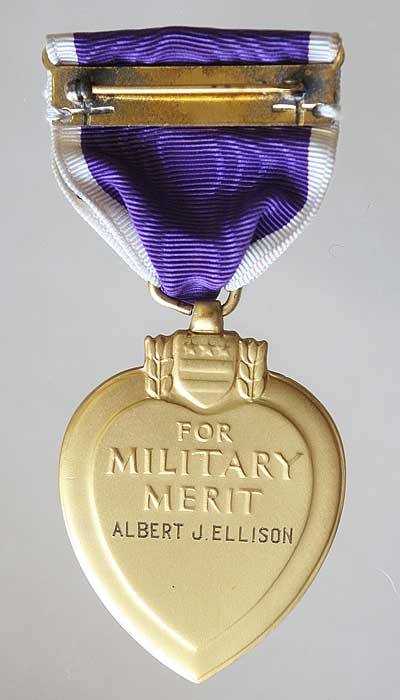
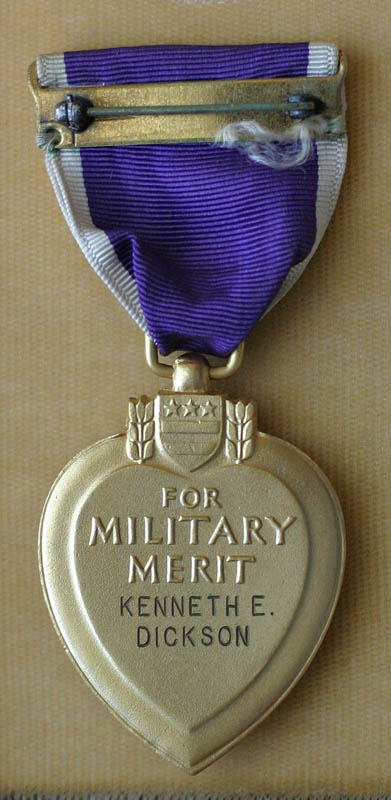

 0
0 -
This has been sitting in my cupboard for a couple of years.
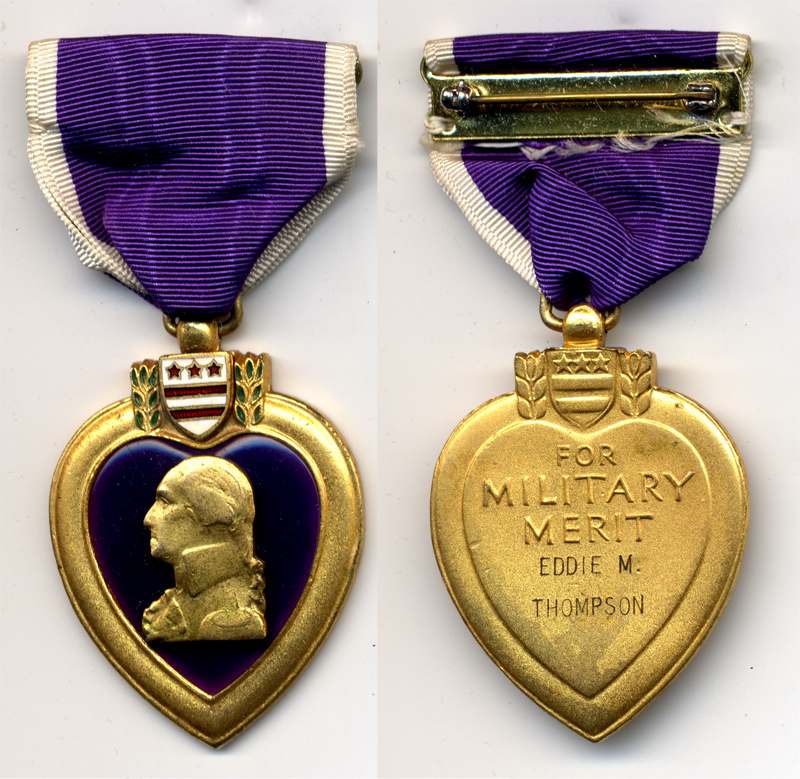
 0
0 -
I'd heard and read of 40mm RK ribbon but had never seen any until this 50.5 cm piece came my way.
Paddy Keating

 0
0 -
Another facsimile signature from December 1943. Note the Fliegerdivision 7 stamp.
PK
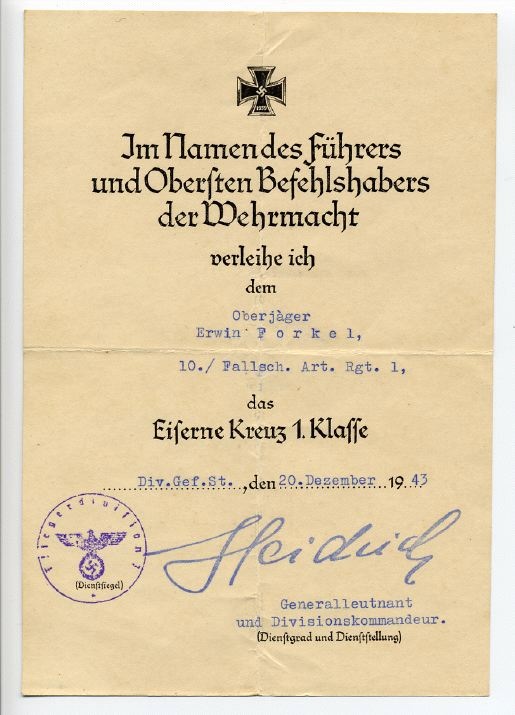
 0
0 -
That's a facsimile signature but here's a manuscript version. I think Viktor Wollner probably survived the war as there is nobody of that name listed KIA in 1944 or 1945 or as having died in 1946.
PK
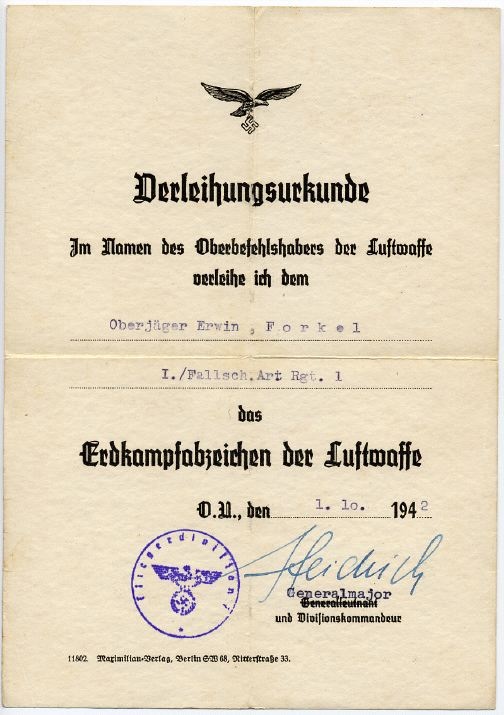
 0
0 -
A Sturmabzeichen document annotated "Silber", indicating that the recipient received the Infanterie-Sturmabzeichen. This document could have been used for the Allgemeines-Sturmabzeichen and for the ISA in Bronze.
PK
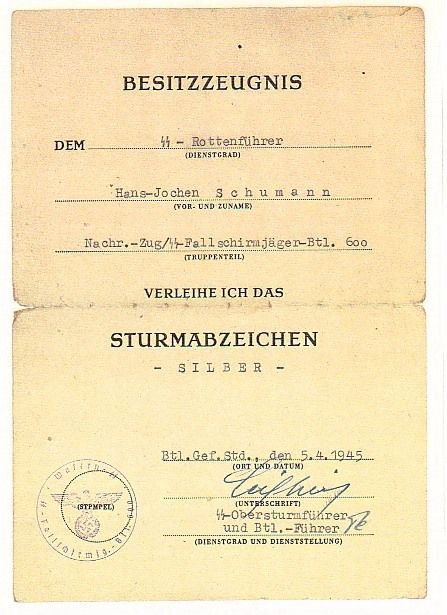
 0
0 -

A classic 2nd Class Iron Cross award document for Monte Cassino to Obergefreiter Viktor Wollner of 3./Fallschirmj?ger-Regiment 1. Wollner was a member of the FJR1?s 1st Battalion. The document bears the stamp of 1. Fallschirmj?ger-Division and the stamp signature of the divisional commander Richard Heidrich. It has been folded over twice, indicating that it was carried in the recipient?s paybook.
PK
0 -
Not at all! What you have written is very interesting to me! I knew a man in London who was one of the organisers of the FFL S?ction Grande Bretagne. He had been some kind of acrobat at the Cirque d'Hiver but was a bit of a "bad boy" on the side. He told me he enlisted in the L?gion to "disappear" and that he said he was Belgian. Maybe he meant the Bat d'Af! Anyway, all was forgotten and forgiven when I knew him as we used to go to the French Embassy for FFL--related events together. I have sent you a PM. Our meeting is long-overdue!
P
0




Narvik
in Germany: Third Reich: Research, Documentation & Photographs
Posted · Edited by PKeating
A Spie? from Gebirgsj?ger-Rgt 100 with his Narvikschild and the Parachutist Badge he received as one of the GJ who underwent a short parachute training course at Stendal to prepare for the jump outside Narvik. This image appears to have been lifted from a film, probably an 8mm "home movie" shot by one of his comrades, judging by the lack of definition.
PK